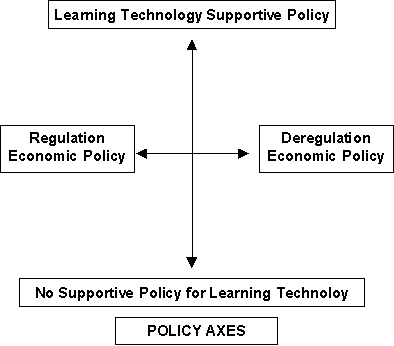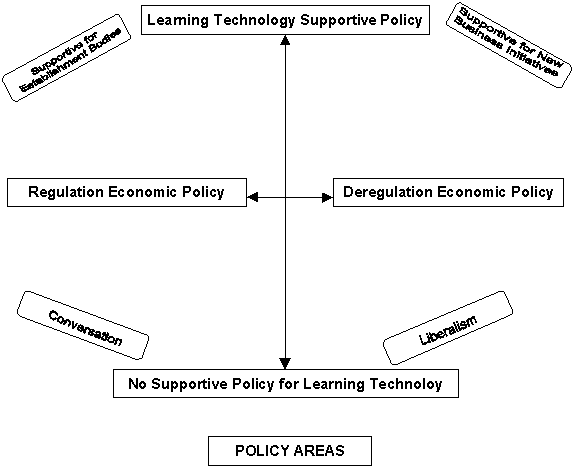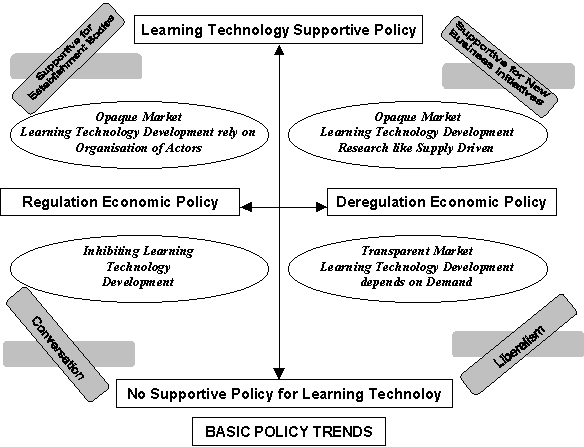A tool for mapping policies
Eric Barchechath
Open Studio, Paris, France
This paper exists also in a French version.
© 1997
Abstract
This paper suggests a possible classification of different policies adopted by Europe’s countries not based on policies specific features but as regards to the continuum between the two poles of regulation/deregulation and the two poles of supportive/non supportive for learning technology. In this way at the crossing of these policy axes four policy areas are defined in which a country can be ideally placed as a policy environment with regard to ODL. Examples are then made of consequences of the four "policy environments" for different classes of actors.
Keywords
Policy axes
Policy areas
Basic policy trends
Policy axes
The different governments of Europe do not weigh up the economic systems or adopt the same forms of incitation. Two major forms are present as economic trends in European countries. One is based on the logic of deregulation, the other on the logic of regulation. In fact there is no one of our countries in which these forms are “pure”.
The history of the nations of Europe structured complex and sedimented organisational modes. Consequently, depending on industrial sector, States competence areas, strategic stakes of the nations within Europe, internal and external competition, the degrees of regulation and deregulation vary from country to country, and from industrial sector to industrial sector.
The question of opening up political will towards technological development may be demarcated by two further criteria. In certain countries, learning technologies are the object of a special attention of public authorities which support their development. In other countries learning technologies may be not supported being beyond the competence of the State. In that case learning technology development may divert to regional bodies, or even may not be taken up at any level at all (national or regional).

These four poles (deregulation / regulation, learning technology supportive / absence of support to learning technology), may be plotted on graphs indicating forms of possible development of technologies with regard to the different contexts.
It is essential to understand that the proposed mapping does not imply for a given country that it should be exclusively classified in one of the described area. Reality is much more complex, each potential market segment faces its own environment and offers a special profile context which can borrow and combine different features belonging to different areas. Therefore this mapping is to be used as a tool for describing a policy framework set by policy initiatives, an environment which exerts constraints on the forms of development of learning technology.
Policy areas

These axes are structuring four spaces that can be sketched roughly:
- At the crossing of political/economic regulation and policy support for the development of learning technology is displayed a space characterised by the support given to establishment bodies. In a regulated economy, public initiatives use as leverage means the bodies that are under the State control or more generally entities that are dependant from the State. This area can be considered as an area where political will drives the development articulating on “vassalised” bodies.
- At the crossing of political/economic deregulation and policy support for the development of learning technology is displayed a space characterised by the support given to new business creation. Initiatives are considered according their potentiality for creating new industrial activities either in the field of products or in the one of services. This area can be considered as an area of voluntarism where political will articulates on entrepreneurs' undertakings.
- At the crossing of political/economic deregulation and absence of support for the development of learning technology is displayed a space that can be defined as a Liberalism area. Here market law plays the major role. Depending on the demand for learning technology, learning technology develops or not.
- At the crossing of political/economic regulation and absence of support for the development of learning technology is displayed a space that can be defined symmetrically to the previous one as a Conservatism area. Learning technology have to develop in an hostile environment as far as actual arrangements and relations of power raise a barrier to innovation.
Each of the quadrants along the two axes characterises a particular positioning of the institutional environment according to their potential to develop learning technologies.
Basic policy trends

Obviously, the four spaces do not represent the same types of development.
The quadrant to the top left, showing policies supportive to establishment bodies, is characterised by markets which are commercially “opaque” in the sense that frontiers between commercial exchange and “internal” exchange are blurred and that commercial exchange takes time to surface clearly on the market. Here the larger institutional operators organise themselves in operational partnerships. There is a trend there where the development of learning technology relies upon two main categories of actors: national telecommunication operators and the larger suppliers of public education (large education and training institutions dependent on the public authorities and universities). The global logic is more service-oriented than product-oriented.
The quadrant to the top right (Voluntarism supportive for new business initiatives) is characterised by markets which are also commercially opaque, but differently than previously: public intervention affects the price: support for the development of educational materials, support for the producers developing tools, support for producers of hardware for public and educational market etc. The trend here seems to fit with the development of individual learning stations whether they are based on CD-ROM, CD-I, interactive-video or computer-based training. Following the rationality of the product market, one remains within this sphere of education. Technology escalation, ever-increasing technical possibilities, which are possibly at play in this framework, slows down the development of a fluid market. Logic here is supply-based.
The quadrant to the bottom right (Liberistic) is characterised by the transparency of the market, neither constraining nor influencing the organisation of the learning technology market. Constraints here are only represented by existing arrangements of the force as they are destabilised by the deregulation policy. Only the initiative of providers and the quality of commodities and services provided is likely to generate the emergence of demand. On the one hand, the learning technology market relies on the demand of enterprises for resources and services which allow effective education and training. On the other hand, the development of the domestic market relies on the quality of supply.
In that framework, enterprises requirements are determinant for learning technology development as there is no public initiatives. And, on the domestic market, this scenario gives the strategic advantage to new operators who are more capable of formulating new needs and assuring their marketability. In this scenario the competition between computer-based stream or channel (multimedia stations based on personal computers and CD-ROM) and the general-public stream is strategic.
The quadrant to the bottom left (Conservatism) is characterised by the avoidance of the strategic stakes of learning technology development. The institutional markets are not encouraged to develop learning technology. The institutional coalitions of power are put in a defensive position and freeze the possibility of the integration of innovation in the more politically oriented sectors (education and training). It is the domestic market which could show the way to other sectors of development: training in general and public education. The trend here could be formulated as such: mass market development based on a cross between education and entertainment (edutainment) reaching the domestic market could act as a leverage for further steps in institutional sectors.
The description of these four institutional positions intends to give an image of possible extreme constraints occurring in the field and imposed as an environment to the stakeholders that are developing flexible and distance learning technology and facilities.
As a matter of fact, when considering just one of the different markets which are presently surfacing in a given country, one will certainly find features belonging to the different areas described above: this both reveals certainly the complexity of managing innovation in our countries and also calls certainly for pragmatism.

